Mises, Ludwig von. Human Action: A Treatise on Economics
Подождите немного. Документ загружается.

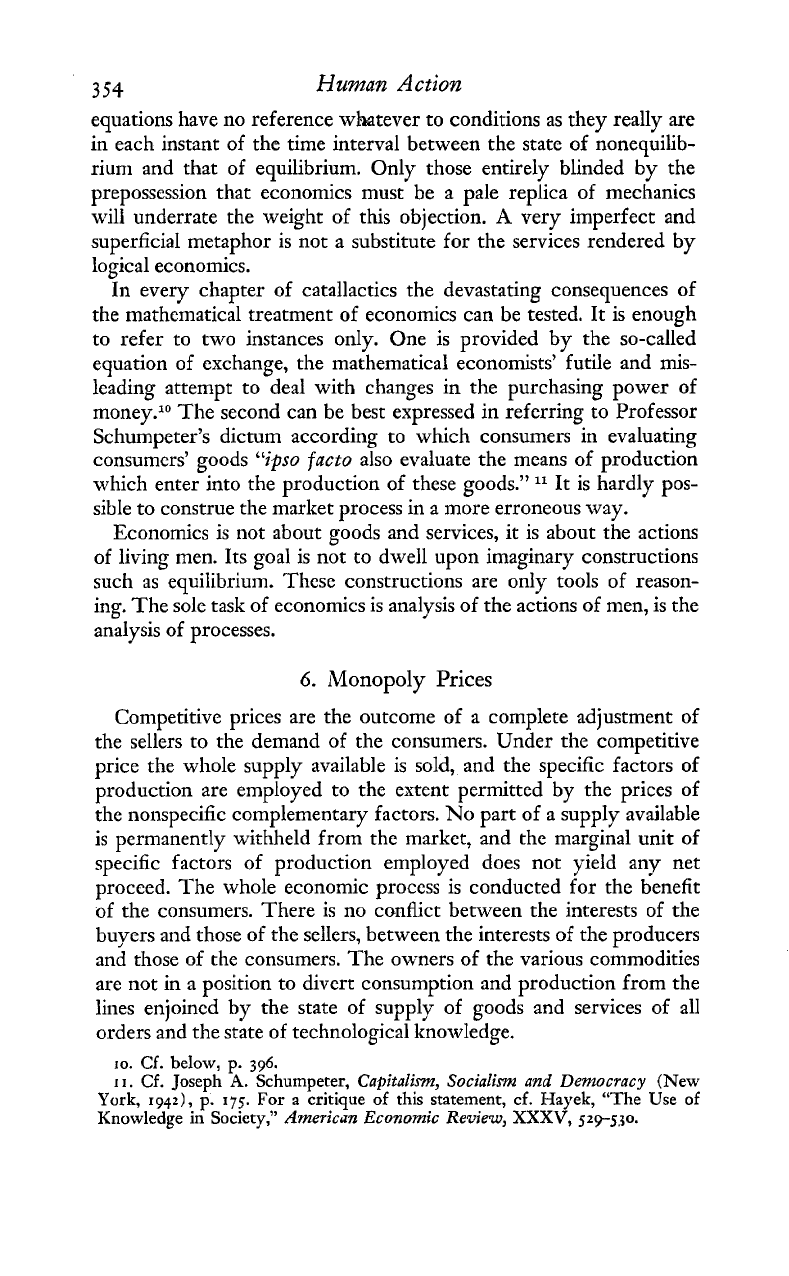
3
54
Human
Action
equations have no reference whatever to conditions as they really
are
in each instant of the time interval between the state of nonequilib-
rium and that of equilibrium. Only those entirely blinded by the
prepossession that economics must be a pale replica of mechanics
will underrate the weight of this objection.
A
very imperfect and
superficial metaphor is not a substitute for the services rendered by
logical economics.
In every chapter of catallactics the devastating consequences of
the mathematical treatment of economics can be tested. It is enough
to refer to two instances only. One is provided by the so-called
equation of exchange, the mathematical economists' futile and mis-
leading attempt to deal with changes in the purchasing power of
money.1° The second can be best expressed in referring to Professor
Schumpeter's dictum according to which consumers in evaluating
consumers' goods
"ipso
facto
also evaluate the means of production
which enter into the production of these goods."
l1
It is hardly pos-
sible to construe the market process in a more erroneous way.
Economics is not about goods and services, it is about the actions
of living men. Its goal is not to dwell upon imaginary constructions
such as equilibrium. These constructions are only tools of reason-
ing. The sole task of economics is analysis of the actions of men, is the
analysis of processes.
6.
Monopoly Prices
Competitive prices are the outcome of a complete adjustment of
the sellers to the demand of the consumers. Under the competitive
price the whole supply available is sold, and the specific factors of
production are employed to the extent permitted by the prices of
the nonspecific complementary factors. No part of a supply available
is permanently withheld from the market, and the marginal unit of
specific factors of production employed does not yield any net
proceed. The whole economic process is conducted for the benefit
of the consumers. There is no conflict between the interests of the
buyers and those of the sellers, between the interests of the producers
and those of the consumers. The owners of the various commodities
are not in a position to divert consumption and production from the
lines enjoined by the state of supply of goods and services of all
orders and the state of technological knowledge.
10.
Cf.
below,
p.
396.
I
I.
Cf.
Joseph
A.
Schumpeter,
Capitalism, Socialism and Democracy
(New
York,
1942),
p.
175.
For a critique of this statement, cf. Hayek, "The Use of
Knowledge in Society,"
American Economic Review,
XXXV,
5zp-5.30.
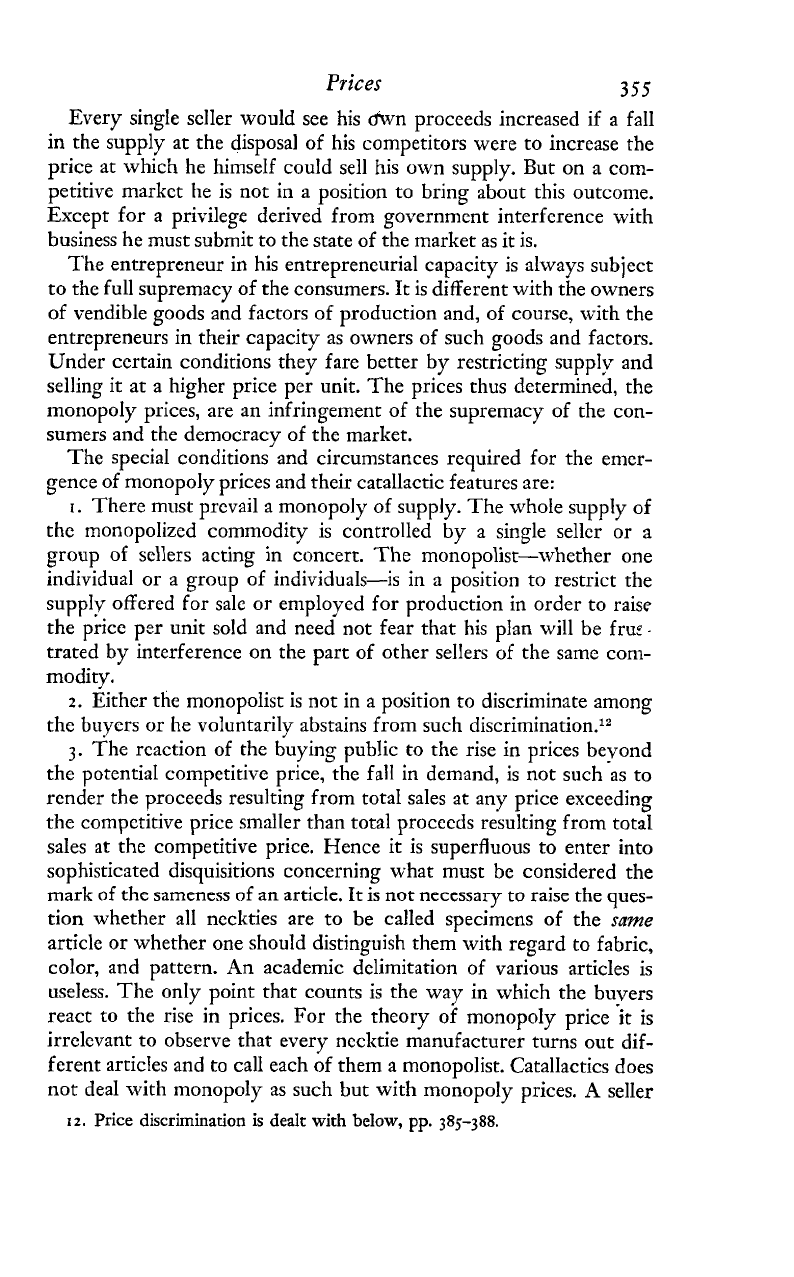
Prices
355
Every single seller would see his &vn proceeds increased if a fall
in the supply at the disposal of his competitors were to increase the
price at which he himself could sell his own supply. But on
a
com-
petitive market he is not in a position to bring about this outcome.
Except for a privilege derived from government interference with
business he must submit to the state of the market as it is.
The entrepreneur in his entrepreneurial capacity is always subject
to the full supremacy of the consumers. It is different with the owners
of vendible goods and factors of production and, of course, with the
entrepreneurs in their capacity as owners of such goods and factors.
Under certain conditions they fare better by restricting supply and
selling it at a higher price per unit. The prices thus determined, the
monopoly prices, are an infringement of the supremacy of the con-
sumers and the democracy of the market.
The special conditions and circumstances required for the enler-
gence of monopoly prices and their catallactic features are:
I.
There must prevail a monopoly of supply. The whole s~zpply of
the monopolized commodity is controlled by a single seller or a
group of sellers acting in concert. The monopolist-whether one
individual or a group of individuals-is in a position to restrict the
supply offcred for sale or enlployed for production in order to raise
the price per unit sold and need not fear that his plan will be fru!
.
trated by interference on the part of other sellers of the same com-
modity.
2.
Either the monopolist is not in a position to discriminate among
the buyers or he voluntarily abstains from such discrimination.12
3.
he
reaction of the buying public to the rise in prices bevond
the potential competitive price, the fall in demand, is not such-as to
render the proceeds resulting from total sales at any price exceeding
the competitive price smaller than total proceeds resulting from total
sales
at
the competitive price. Hence it is superfluous to enter into
sophisticated disquisitions concerning what must be considered the
mark of the sameness of an article. It is not necessary to raise the ques-
tion whether all neckties are to be called specimens of the
same
article or whether one should distinguish them with regard to fabric,
color, and pattern. An academic delimitation of various articles is
useless. The only point that counts is the way in which the buvers
react to the rise
in
prices. For the theory of monopoly price
-it
is
irrelevant to observe that every necktie manufacturer turns out dif-
ferent artides and to call each of them a monopolist. Catallactics does
not deal with monopoly as such but with monopoly prices. A seller
x
2.
Price discrimination is dealt
with
below,
pp.
385-388.
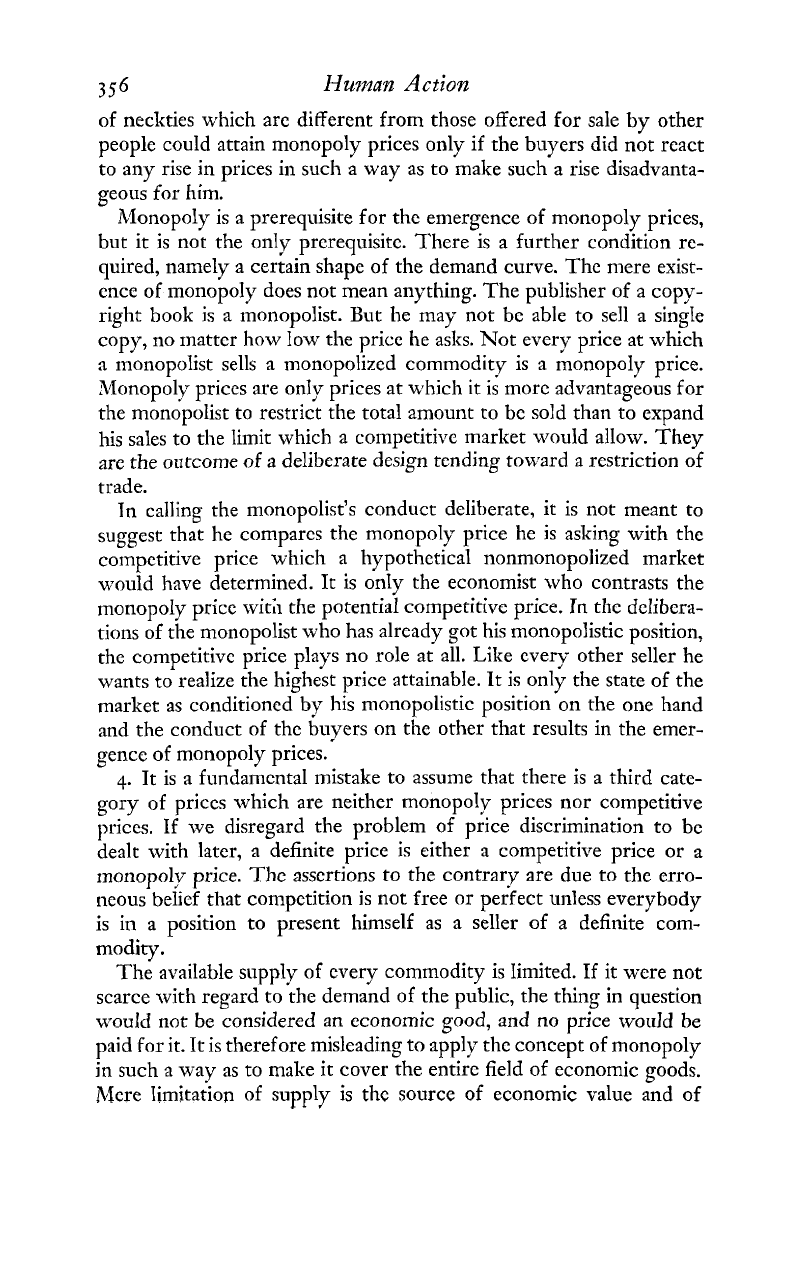
356
Human
Action
of neckties which arc different from those offered for sale by other
people could attain monopoly prices only if the buyers did not react
to any rise in prices in such a way as to make such
a
rise disadvanta-
geous for him.
itlonopoly is a prerequisite for the emergence of monopoly prices,
but it is not the only prerequisite. There is a further condition re-
quired, namely a certain shape of the demand curve. The mere exist-
ence of monopoly does not mean anything. The publisher of a copy-
right book is a monopolist. But he may not be able to sell a single
copy, no matter how low the price he asks. hTot every price at which
a monopolist sells
a
monopolized commodity is a monopoly price.
Monopoly prices are only prices at which it is more advantageous for
the monopolist to restrict the total amount to be sold than to expand
his sales to the limit which a competitive market would allow. They
are the outcome of
a
deliberate design tending toward a restriction of
trade.
Tn calling the monopolist's conduct deliberate, it is not meant to
suggest that he compares the monopoly price he is asking with the
competitive price which a hypothetical nonmonopolized market
would have determined. It is only the economist who contrasts the
~nonopoly price with the potential competitive price. Tn the dclibcra-
tions of the monopolist who has already got his monopolistic position,
the competitive price plays no role at all. Like every other seller he
wants to realize the highest price attainable. It is only the state of the
market as conditioned by his monopolistic position on the one hand
and the conduct of the buyers on the other that results in the emer-
gence of monopoly prices.
4.
It is a fundamental mistake to assume that there is a third cate-
gory of prices which are neither monopoly prices nor competitive
prices.
If
we
disregard the problem of price discrimination to be
dealt with later, a definite price is either
a
competitive price or a
monopoly price. The assertions to the contrary are due to the erro-
neous belief that competition is not free or perfect unless everybody
is in a position to present himself as a seller of a definite com-
modity.
The available supply of every commodity is Iimited. If it were not
scarce with regard to the demand of the public, the thing in question
would not be considered an economic good, and no price would be
paid for it. It is therefore misleading to apply the concept of monopoly
in such a way as to make it cover the entire field of economic goods.
Mere 1imitaGon of supply is
thc
source of economic value and of
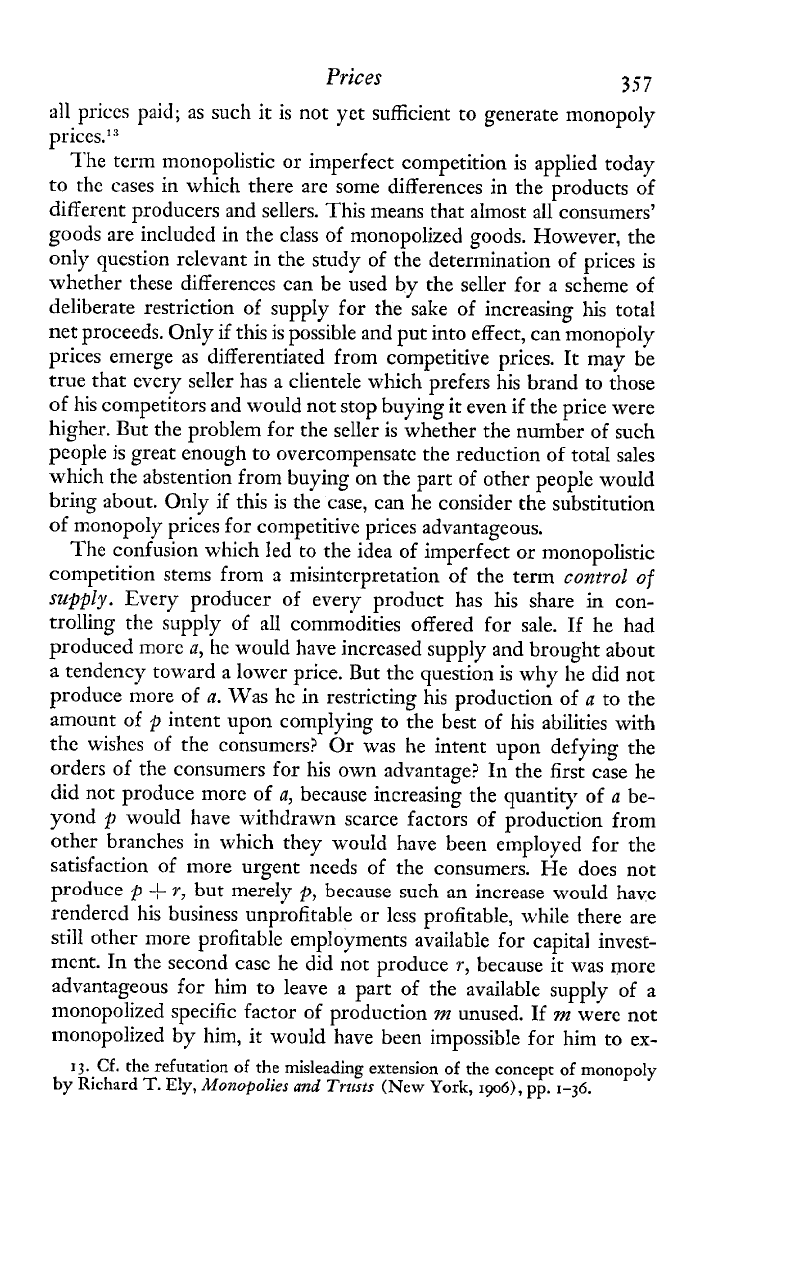
Prices
357
all prices paid; as such it is not yet sufficient to generate monopoly
prices.13
The term monopolistic or imperfect competition is applied today
to the cases in which there are some differences in the products of
different producers and sellers. This means that almost all consumers'
goods are included in the class of monopolized goods. However, the
only question relevant in the study of the determination of prices is
whether these differences can be used by the seller for a scheme of
deliberate restriction of supply for the sake of increasing his total
net proceeds. Only if this is possible and put into effect, can monopoly
prices emerge as differentiated from competitive prices. It may be
true that every seller has a clientele which prefers his brand to those
of his competitors and would not stop buying it even if the price were
higher. But the problem for the seller is whether the number of such
people is great enough to overcompensate the reduction of totaI sales
which the abstention from buying on the part of other people would
bring about. Only if this is the case, can he consider the substitution
of monopoly prices for competitive prices advantageous.
The confusion which led to the idea of imperfect or monopolistic
competition stems from a misinterpretation of the term
control
of
supply.
Every producer of every product has his share in con-
trolling the supply of all commodities offered for sale. If he had
produced more
a,
he would have increased supply and brought about
a tendency toward a lower price. But the question is why he did not
produce more of
a.
Was he in restricting his production of
a
to the
amount of
p
intent upon complying to the best of his abilities with
the wishes of the consumers? Or was he intent upon defying the
orders of the consumers for his own advantage? In the first case he
did not produce more of
a,
because increasing the quantity of
n
be-
yond
p
would have withdrawn scarce factors of production from
other branches in which they would have been employed for the
satisfaction of more urgent needs of the consumers. He does not
produse
p
+
r,
hut
mere!^
p,
because such
an
increase
wdd
have
rendercd his business unprofitable or less profitable, while there are
still other more profitable employments available for capital invest-
ment. In the second case he did not produce
r,
because it was more
advantageous for him to leave a part of the available supply of a
monopolized specific factor of production
m
unused. If
m
were not
monopolized by him, it would have been impossible for him to ex-
r
3.
Cf.
the refutation of the misleading extension of the concept of monopoly
by
Richard
T.
Ely,
Alonopolies
~nd
Trusts
(New
York,
1906),
pp.
1-36.
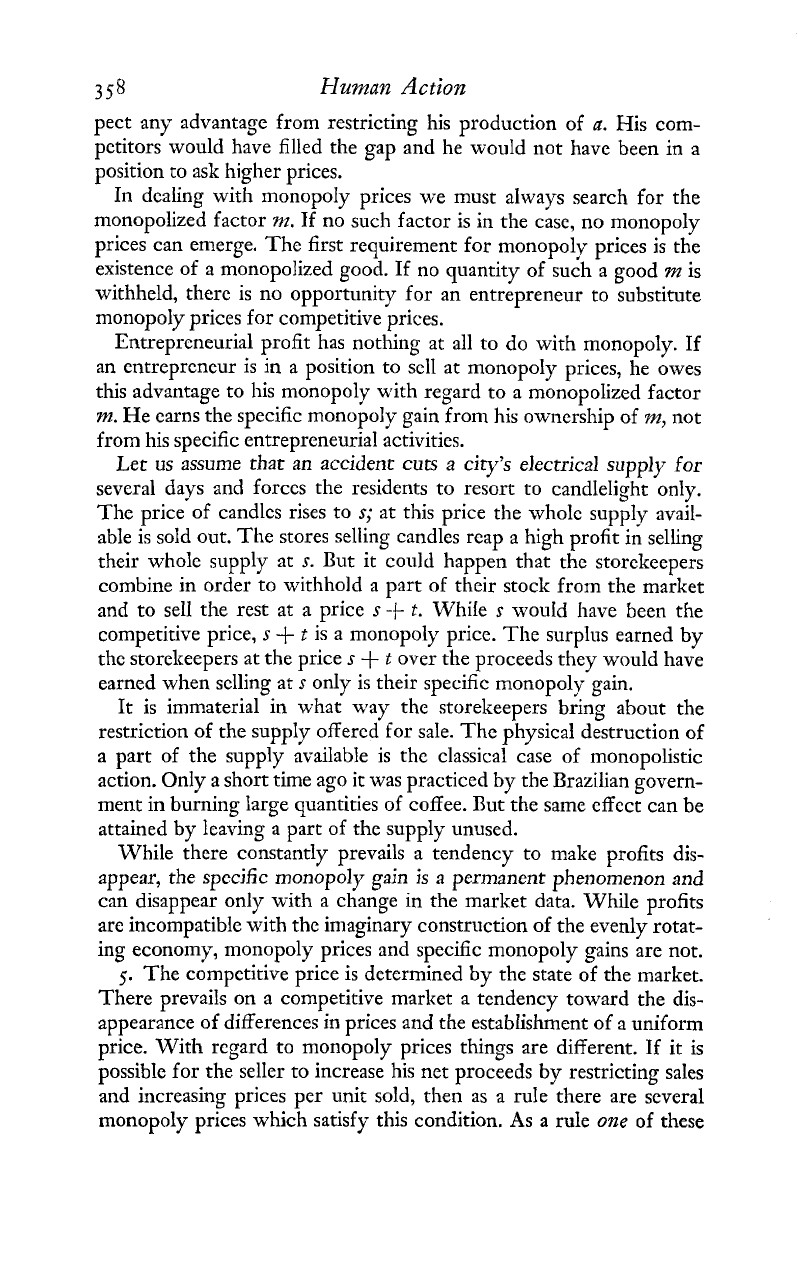
3
58
Human
Action
pect any advantage from restricting his production of
a.
His com-
petitors would have filled the gap and he would not have been in
a
position to ask higher prices.
In dealing with monopoly prices we must always search for the
monopolized factor
7n.
If no such factor is in the case, no monopoly
prices can emerge. The first requirement for monopoly prices is the
existence of
a
monopolized good. If no quantity of such a good
nz
is
withheld, there is no opportunity for an entrepreneur to substitute
monopoly prices for competitive prices.
Entrepreneurial profit has nothing at all to do with monopoly.
If
an entrepreneur is
in
a position to sell at monopoly prices, he owes
this advantage to his monopoly with regard to a monopolized factor
m.
He earns the specific monopoly gain from his ownership of
m,
not
from his specific entrepreneurial activities.
Let us assume that an accident cuts a city's electrical supply for
several days and forces the residents to resort to candlelight only.
The price of candles rises to
s;
at this price the whole supply avail-
able is sold out. The stores selling candles reap a high profit ii selling
their whole supply at
s.
But it could happen that the storekeepers
combine in order to withhold a part of their stock from the market
and to sell the rest at a price
s
-+
t.
While
s
would have been the
competitive price,
s
+
t
is a monopoly price. The surplus earned by
the storekeepers at the price
s
+
t
over the proceeds they would have
earned when selling at
s
only is their specific monopoly gain.
It is immaterial in what way the storekeepers bring about the
restriction of the supply offered for sale. The physical destruction of
a part of the supply availabIe is the classical case of monopolistic
action. Only a short time ago
it
was practiced by the Brazilian govern-
ment in burning large quantities of coffee. nut the same effect can be
attained by leaving a part of the supply unused.
While there constantly prevails a tendency to make profits dis-
appear, the specific monopoly gain is a permanent phenomenon and
can disappear only with a change in the market data. While profits
are incompatible with the imaginary construction of the evenly rotat-
ing economy, monopoly prices and specific monopoly gains are not.
5.
The competitive price is determined by the state of the market.
There prevails on a competitive market a tendency toward the dis-
appearance of differences in prices and the establishment of a uniform
price. With regard to monopoly prices things are different. If it is
possible for the seller to increase his net proceeds by restricting sales
and increasing prices per unit sold, then as a rule there are several
monopoly prices which satisfy this condition.
As
a rule
one
of these
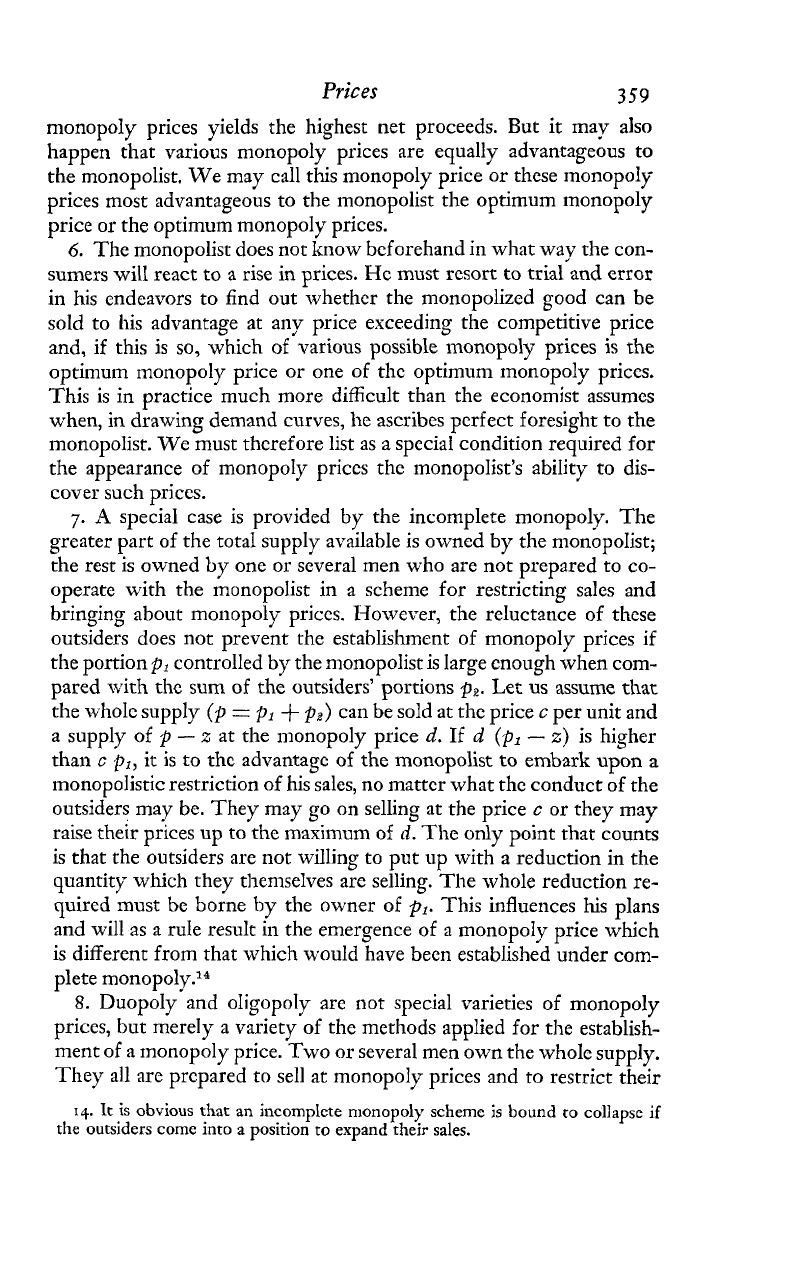
Prices
3
59
monopoly prices yields the highest net proceeds. But
it
may also
happen that various monopoly prices are equally advantageous to
the monopolist. We may call this monopoly price or these monopoly
prices most advantageous to the monopolist the optimum ~nonopoly
price or the optimum monopoly prices.
6.
The monopolist does not know beforehand in what way the con-
sumers
will
react to a rise in prices.
Hc
must resort to trial
and error
in his endeavors to find out whether the monopolizcd good can be
sold to his advantage at any price exceeding the competitive price
and, if this is so, which of various possible monopoly prices is
the
optimum monopoly price or one of the optimum rnonopoly prices.
This is in practice much more difficult than the economist assumes
when, in drawing demand curves, he ascribes perfect foresight to the
monopolist. We must therefore list as a special condition required for
the appearance of monopoly priccs the monopolist's abiIity to dis-
cover such prices.
7.
A
special case is provided by the incomplete monopoly. The
grcater part of the totaI supply available is owned
by
the n~onb~o~ist;
the rest is owned by one or several men who are not prepared to co-
operate with the monopolist in a scheme for restricting sales and
bringing about monopoly priccs. However, the reluctance of these
outsiders does not prevent the establishment of monopoly prices if
the portion
p,
controlled
by
the monopolist is large enough when com-
pared with the sum of the outsiders' portions
p,.
Let us assume that
the whole supply
(p
=
p,
+
p,)
can be sold at the price
c
per unit and
a supply of
p
-
z
at the monopoly price
d.
If
d
(p,
-
z)
is higher
than
c
p,,
it is to the advantage of the monopolist to embark upon a
lnonopolistic restriction of his sales, no matter what the conduct of the
outsiders may be. They may go on selling at the price
c
or they may
raise their pkes up to the maximum of
d.
The only point that counts
is that the outsiders are not willing to put
up
with a reduction in the
quantity which they themselves are selling. The whole reduction re-
quired must be borne
by
the owner of
p,.
This influences his plans
and will as a rule result in the emergence of a monopoly price which
is different from that which would have been established under com-
plete monopoly.14
8.
Duopoly and oIigopoly are not special varieties of monopoly
prices, but merely a variety of the methods applied for the establish-
ment of a rnonopoly price. Two or several men own the whole supply.
They all are prepared to sell at monopoly prices and to restrict their
14.
It
is
obvious
that
an incomplete nionopolp scheme
is
bound to collapse
if
the outsiders come into
a
position to expand their sales.
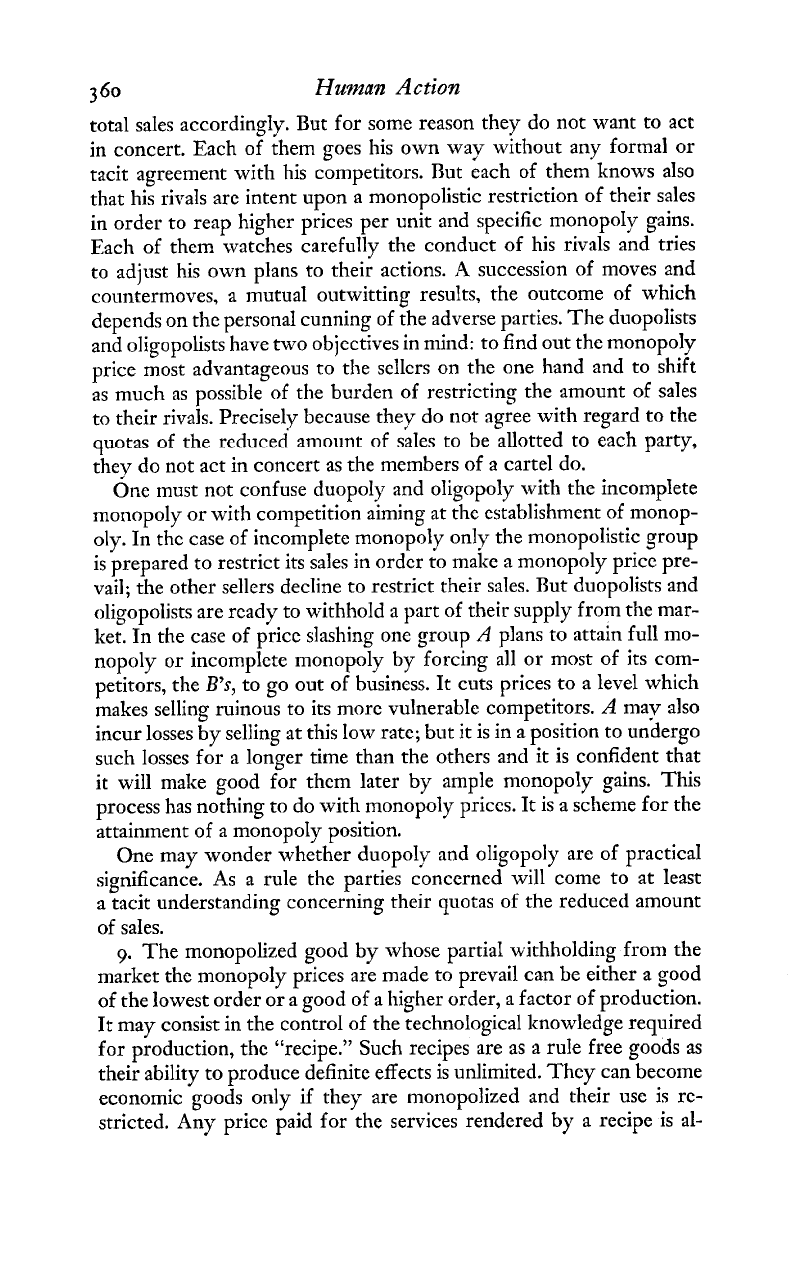
360
Hu7;1zan
Action
total sales accordingly. But for some reason they do not want to act
in concert. Each of them goes his own way without any formal or
tacit agreement with his competitors. But each of them knows also
that his rivals are intent upon
R
monopolistic restriction of their sales
in order to reap higher prices per unit and specific monopoly gains.
Each of thcm watches carefully the conduct of his rivals and tries
to adjust his own plans to their actions.
A
succession of moves and
countermoves, a mutual outwitting results, the outcome of which
depends on the personal cunning of the adverse parties. The duopolists
and oligopolists have two objectives in mind: to find out the monopoly
price most advantageous to the sellers on the one hand and to shift
as much as possible of the burden of restricting the amount of sales
to their rivals. Precisely because they do not agree with regard to the
quotas of the reduced amount of sales to be allotted to each party,
they do not act in concert as the members of
a
cartel do.
One must not confuse duopoly and oligopoly with the incomplete
monopoly or with competition aiming at the
establishment
of monop-
oly. In thc case of incon~plete monopoly only the monopolistic group
is prepared to restrict its sales in ordcr to make a monopoly pricc pre-
vail; the other sellers decline to restrict their sales. But duopolists and
oligopolists are rcady to withhold a part of their supply from the mar-
ket. In the case of pricc dashing one group
A
plans to attain fuII mo-
nopoly or incomplete monopoly by forcing all or most of its com-
petitors, the
B's,
to go out of business. It cuts prices to a level which
makes selling ruinous to its morc vulnerable competitors.
A
mav also
incur losses by selling at this low rate; but it is in a position to unhergo
such losses for a longer time than the others and it is confident that
it will make good for them later by ample monopoly gains. This
process has nothing to do with monopoly prices. It is a scheme for the
attainment of a monopoly position.
One may wonder whether duopoly and oligopoly are of practical
significance. As a rule the parties concerned will come to at least
a tacit understanding concerning their quotas of the reduced amount
of sales.
9.
The monopolized good by whose partial withholding from the
market the monopoly prices are made to prevail can be either a good
of the lowest order or a good of a higher order, a factor of production.
It may consist in the control of the technological knowledge required
for production, the "recipe." Such recipes are as a rule free goods as
their ability to produce definite effects is unlimited. They can become
economic goods only if they are monopolized and their use is re-
stricted. Any pricc paid for the services rendered by a recipe is al-
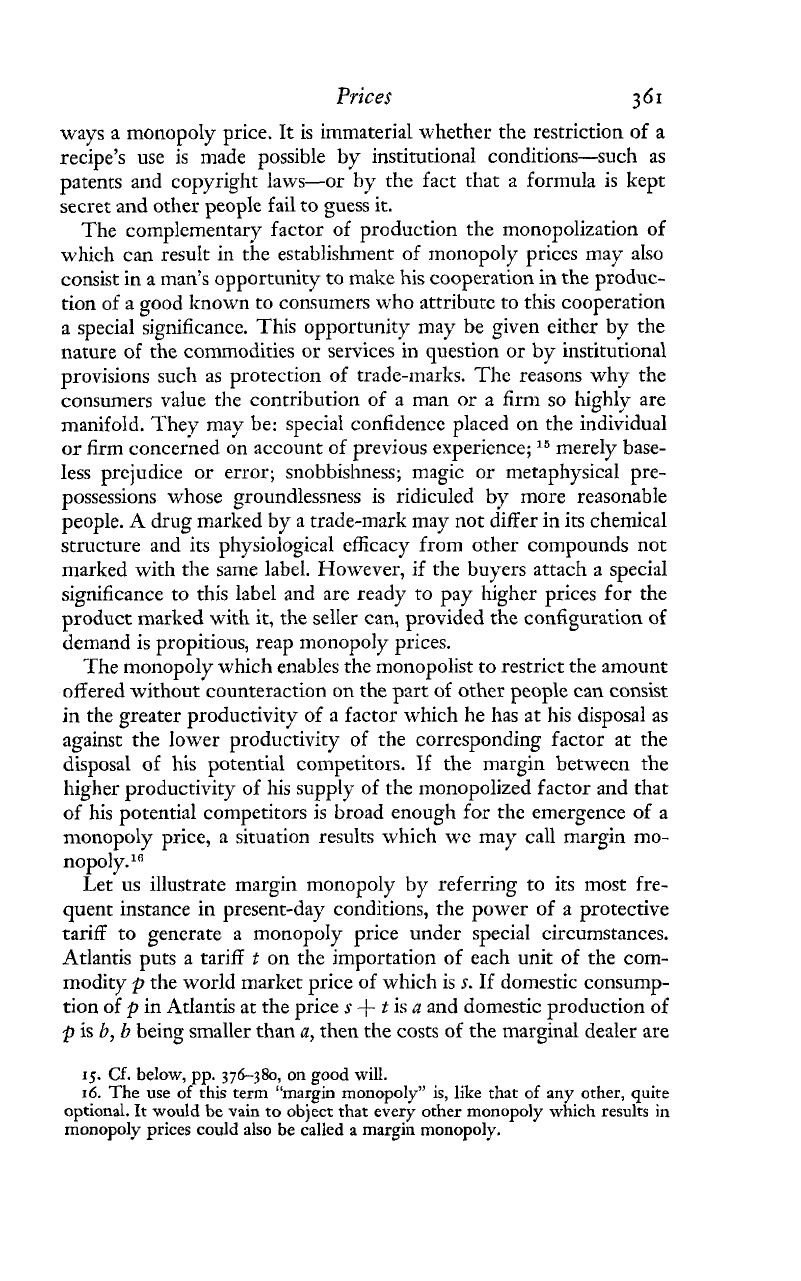
Prices
361
ways a monopoIy price. It is immaterial whether the restriction of a
recipe's use is made possible by institutional conditions-such as
patents and copyright laws-or by the fact that a formula is kept
secret and other people fail to guess it.
The complementary factor of production the monopolization of
which can result in the establishment of monopoly prices may also
consist in a man's opportunity to make his cooperation
in
the produc-
tion of a good ltnown to consumers who attribute to this cooperation
a special significance. This opportunity may be given either by the
nature of the commodities or services in question or by institutional
provisions such as protection of trademarks. The reasons why the
consumers value the contribution of a man
or
a firm so highly are
manifold. They may be: special confidence placed on the individual
or firm concerned on account of previous experience;
l5
merely base-
less prejudice or error; snobbishness; magic or metaphysical pre-
possessions whose groundlessness is ridiculed by more reasonable
people.
A
drug marked by a trade-mark may not differ in its chemical
structure and its physiological efficacy from other compounds not
marked with the same label. However, if the buyers attach a special
significance to this label and are ready to pay higher prices for the
product marked with it, the seller can, provided the configuration of
demand is propitious, reap monopoly prices.
The monopoly which enables the monopolist to restrict the amount
offered without counteraction on the part of other people can consist
in the greater productivity of a factor which he has at his disposal as
against the lower productivity of the corresponding factor at the
disposal of his potential con~petitors. If the margin between the
higher productivity of his supply of the monopolized factor and that
of his potential competitors is broad enough for the emergence of a
monopoly price, a situation results which we may call margin mo-
nop01y.~"
Let us illustrate margin monopoly by referring to its most fre-
quent instance
in
present-day conditions, the power of a protective
tariff to generate a monopoly price under special circumstances.
Atlantis puts a tariff
t
on the importation of each unit of the com-
modity
p
the world market price of which
is
s.
If domestic consump-
tion of
p
in Atlantis at the price
s
$
t
is
a
and domestic production of
p
is
b, b
being smaller than
a,
then the costs of the ~narginal dealer are
15.
Cf.
below,
pp.
376380,
on good will.
16.
The use of this term "margin monopoly" is, like that
of
any other, quite
optional. It would be vain to object that every other monopoly which results
in
monopoly prices could also be called a margin monopoly.

362
Human
Action
s
+
t.
The domestic plants are in a position to sell their total output at
the price
s
+
t.
The tariff is effective and offers to domestic business
the incentive to expand the prod~~ction of
p
frorn
b
to a quantity
slightly smaller than
a.
But if
b
is greater than
a,
things are different.
If we assume that
h
is so large that even at the price
s
domestic con-
sumption lags behind it and the surplus must be exported and sold
abroad, the imposition of a tariff does not affect the price of
p.
Both
the domestic and the world market price of
p
remain unchanged.
However the tariff, in discriminating between domestic and foreign
production of
p,
accords to the domestic plants
a
privilege which
can be used for a monopolistic combine, provided certain further
conditions are present. If it is possible to find within the margin be-
tween
s
+
t
and
s
a monopoly price, it becomes lucrative for the
domestic enterprises to form a cartel. The cartel sells in the home
market of Atlantis at a monopoly price and disposes of the surpluz
abroad at the world market price. Of course, as the quantity of
p
offered at the world market increases as a consequence of ;he re-
striction of the quantity sold
in
Atlantis, the world market price drops
from
s
to
s,.
It is therefore a further requirement for the emergence
of the domestic monopoly price that the total restriction in proceeds
resulting from this fa11 in the world market price is not so great as
to absorb the whole monopoly gain of the domestic cartel.
In the long run such a national cartel cannot preserve its monopo-
listic position if entrance into its branch of production is free to
newcomers. The monopolized factor the services of which the cartel
restricts (as far as the domestic market is concerned) for the sake of
monopoly prices is a geographical condition which can easily be
duplicated by every new investor who establishes a new plant within
the borders of Atlantis. Under modern industrial conditions, thc
characteristic feature of which is steady technological progress, the
latest plant will as a rule be more efficient than the older plants and
produce at lower average costs. The incentive to prospective new-
comers is therefore twofoid.
it
consists not oniy in the monopoiy gain
of the cartel members, but also in the possibility of outstripping
them by lower costs of production.
Here again institutions come to the aid of the old firms that form
the cartel. The patents give them a legal monopoly which nobody
may infringe. Of course, only some of their production processes
may be protected by patents. But a competitor who is prevented
from resorting to these processes and to the production of the articles
concerned may be handicapped in such a serious way that he cannot
consider entrance into the field of the cartelized industry.

Prices
363
The owner of a patent enjoys a legal monopoly which, other condi-
tions being propitious, can be used for the attainment of monopoly
prices. Beyond the field covered by the patent itself a patent may
render auxiliary services in the establishment and preservation of mar-
gin monopoly where the primary institutional conditions for the emer-
gence of such a monopoly prevail.
We may assume that some world cartels would exist even in the
absence o'f any government interference which provides for other
commodities the indispensable conditions required for the construc-
tion
of
a
monopolistic combine. There are some
commodities,
e.g.,
diamonds and mercury, the supply of which is by nature limited to
a few sources. The owners of these resources can easily be united for
concerted action. But such cartels would play only a minor role in
the setting of world production. Their economic significance would
be rather small. The important place that cartels occupy in our time
is an outcome of the interventionist policies adopted by the govern-
ments of all countries. The great monopoly problem mankind has to
face today is not an outgrowth of the operation of the market econ-
omy. It is a product of purposive action on the part of governments.
It is not one of the evils inherent in capitalism as the demagogues
trumpet. It is, on the contrary, the fruit of policies hostile to capitalism
and intent upon sabotaging and destroying its operation.
The classical country of the cartels was Germany. In the last dccadcs
of the nineteenth century the German Reich embarked upon a vast
scheme of
Sozialpolitik.
The idea was to raise the income and the
standard of living of the wage-earners by various measures of what
is called prolabor legislation, by the much glorified Bismarck plan of
social security, and by labor-union pressure and compulsion for the
attainment of higher wage rates. The advocates of this policy defied
thc warnings of the economists. There is no such thing as economic
law, they announced. The HohenzolIern Empire which had defeated
the Emperors of Austria
and
of France
and
before which the nations
of the world trembled was above any law. Its will was the supreme
canon.
In stark reality the Sozialpolitik raised costs of production within
Germany. Every progress of the alleged prolabor legislation and
every successful strike disarranged industrial conditions to the dis-
advakage of the German enterprises. It made it harder for them to
outdo foreign competitors for whom the domestic events of Germany
did not raise costs of production. If the Germans had been in a posi-
tion to renounce the export of manufactures and to produce only for
the domestic market, the tariff could have sheltered the German
